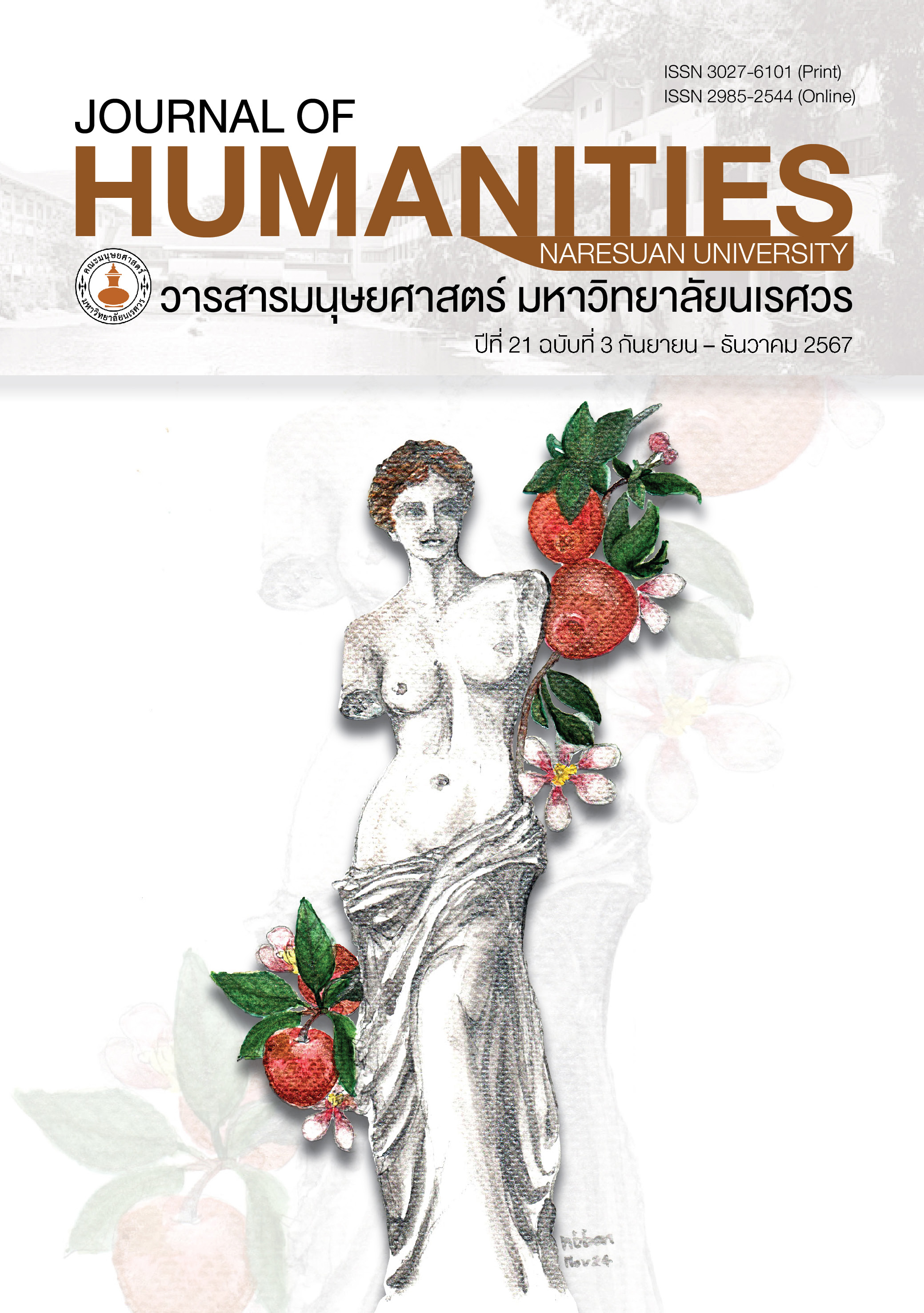แนวคิดด้านหลักสูตรและการสอนกีตาร์ขั้นพื้นฐาน
Main Article Content
บทคัดย่อ
หลักสูตรและการเรียนการสอนกีตาร์คลาสสิกได้รับความนิยมและถูกบรรจุอยู่ในโรงเรียนประถมและมัธยมหรือการศึกษานอกระบบอย่างต่อเนื่องตั้งแต่อดีตจนถึงปัจจุบันเนื่องจากกีตาร์คลาสสิกให้เสียงที่ไพเราะ บรรเลงบทเพลงได้หลากหลายสไตล์ ทั้งยังสามารถบรรเลงประกอบการขับร้อง บรรเลงเดี่ยวหรือรวมวงได้ บทความวิจัยนี้มุ่งเน้นศึกษาหลักสูตร ตำราและวิธีการสอนกีตาร์คลาสสิกขั้นพื้นฐาน เพื่อให้เห็นถึงกระบวนทัศน์ใหม่ของการสร้างองค์ความรู้ ผู้วิจัยพบว่า หลักสูตรและการสอนกีตาร์คลาสสิกขั้นพื้นฐานมีประวัติที่ยาวนาน ลักษณะทางกายภาพของเครื่องดนตรีประเภทกีตาร์ถูกพัฒนาให้สอดรับกับเทคนิคและศิลปะการบรรเลงขั้นสูงที่ส่งผลให้เกิดนักประพันธ์เพลงสำหรับกีตาร์ที่ผลิตตำราการสอนขึ้นอย่างแพร่หลาย ในปัจจุบันหลักสูตรที่ทันสมัยมุ่งเน้นกระบวนการผสมผสานการเรียนแบบดั้งเดิมเชื่อมโยงกับการสร้างเสริมประสบการณ์ผู้เรียนผ่านบทเพลงสมัยนิยมในขณะที่ลดความสำคัญของการอ่านโน้ตสากล อีกทั้งเน้นการฟัง ปลูกฝังความเข้าใจในบทเพลงและเลียนแบบเพื่อสร้างสรรค์ ผู้วิจัยจึงเชื่อว่า กระบวนการดังกล่าวจะทำให้เกิดปรากฏการณ์ใหม่ในแวดวงการเรียนการสอนกีตาร์ที่ “...ความสนุกสนานกับความสำเร็จทางวิชาการไม่ได้เป็นปฏิปักษ์ต่อกัน ทว่าสามารถร่วมสร้างไปด้วยได้อย่างมีนัยสำคัญ” (Incze 2013, p. 1)
Article Details

อนุญาตภายใต้เงื่อนไข Creative Commons Attribution-NonCommercial-NoDerivatives 4.0 International License.
ข้อความรู้ใด ๆ ตลอดจนข้อคิดเห็นใด ๆ เป็นของผู้เขียนแต่ละท่านโดยเฉพาะ คณะมนุษยศาสตร์ มหาวิทยาลัยนเรศวร และกองบรรณาธิการวารสารมนุษยศาสตร์ฯ ไม่จำเป็นต้องเห็นพ้องด้วย
เอกสารอ้างอิง
อนุชา พัฒนรัตนโมฬี. (2553). การพัฒนากิจกรรมการเรียนรู้โดยเน้นการสะสมรูปแบบของจังหวะด้วยสื่อการสอนแบบปฏิสัมพันธ์ เพื่อฝึกการอ่านโน้ตแบบฉับพลันสำหรับนักเรียนกีตาร์ในระดับชั้นต้น (วิทยานิพนธ์ครุศาสตรมหาบัณฑิต). กรุงเทพฯ: จุฬาลงกรณ์มหาวิทยาลัย. สืบค้นจาก https://cuir.car.chula.ac.th/handle/123456789/36472
Berlin, B. D. (2021). Content analysis of guitar repertoire for young people: The Michelson and Suzuki collections (Doctoral dissertation). Lynchburg, VA: Liberty University. Retrieved from https://digitalcommons.liberty.edu/doctoral/2949/
Caluda, G. J. (1985). The development of a method for teaching fundamentals of guitar to college students in music education and music therapy curricula (Doctoral dissertation). Baton Rouge, LA: Louisiana State University and Agricultural & Mechanical College. Retrieved from https://repository.lsu.edu/gradschool_disstheses/4120
Dalen, D. V. (1994). Concepts concerning the scientific method. In M. Langenbach, C. Vaughn, & L. Aagaard (Eds.), An introduction to educational research (pp.103-132). Needham Heights: MA, Allyn & Bacon.
Faizin, S., Pradoko, A. M. S., & Kautsar, C. R. E. (2020). Local Wisdom of Lampung Guitar Petting Performed by Saibatin Ethnic. In Proceedings of the 3rd International Conference on Arts and Arts Education (ICAAE 2019) (pp.110-113). Dordrecht: Atlantis Press. Retrieved from https://doi.org/10.2991/assehr.k.200703.023
Glise, A. (1997). Classical guitar pedagogy: A handbook for teachers. Saint Louis, MO: Mel Bay Publications.
Goodhart, G. (2004). Advocacy guitar classes reach all students. American String Teacher, 54(4), 98-100.
Griffin, R. C. (1989). The Suzuki approach applied to guitar pedagogy (Doctoral dissertation). Coral Gables, FL: University of Miami. Retrieved from https://www.proquest.com/openview/94ebb452ea59668c3f14d9e93454edce/1?pq-origsite=gscholar&cbl=18750&diss=y
Gustafson, G. (1996). Class guitar in middle school. Music Educators Journal, 83(1), 33-38.
Harrison, E. (2010). Challenges Facing Guitar Education. Music Educators Journal, 97(1), 50-55.
Hinsley, M. (2011). Classroom classical guitar. American String Teacher, 61(2), 32-34.
Hoeflicker, C. (2013). A four year curriculum for high school guitar class with a review of the literature on motivation in music education (Doctoral dissertation). Bloomington, IN: Indiana University. Retrieved from https://core.ac.uk/download/pdf/213835647.pdf
Incze, L. S. (2013). Popular guitar pedagogy: Fostering traditional musicianship in the culturally relevant classroom (Master’s thesis). Montréal: McGill University. Retrieved from https://escholarship.mcgill.ca/concern/theses/5712mb252
Kronenberg, C. W. (2013). The pedagogical value of Léo Brouwer’s Études Simples: A perspective on preserving an exquisite, yet neglected custom. International Journal of Music Education, 31(2), 130-147.
Lemoine, P. (2019). Da capo al fine – Retaining high school students in guitar programs (Master’s thesis). Winnipeg: University of Manitoba.
Meltz, J. A. (1976). The guitar as a classroom instrument. American Music Teacher, 26(2), 12-15. Retrieved from https://www.proquest.com/openview/1d5d8486cdd7c27fef7d630588f2ceb2/1?pq-origsite=gscholar&cbl=1819728
Merry, R. (2010). Paradigm for effective pre-college classical guitar methodology: A case study of two models of effective instruction (Doctoral dissertation). Greeley, CO: University of Northern Colorado. Retrieved from https://digscholarship.unco.edu/dissertations/212
Naizer, M. J. (2020). Classical guitar pedagogy: identifying the fundamentals restated, revised, and refashioned (Unpublished thesis). San Marcos, TX: Texas State University. Retrieved from https://hdl.handle.net/10877/13144
Nasrifan, M. N. H., & Kolev, V. S. (2019). Incorporating Malaysian folksongs and Bulgarian classical guitar method for teaching and learning guitar. International Journal of Academic Research in Progressive Education and Development, 8(2), 266-285.
Page, C. (2013). New light on the London years of Fernando Sor, 1815-1822. Early Music, 41(4), 557-569.
Pecoraro, J. (2012). Guitar forum: Starting a class guitar program. American String Teacher, 62(3), 54-57.
Perlovsky, L. (2017). Music, passion, and cognitive function. Cambridge, MA: Elsevier Academic Press.
Phillips, R. (2008). Building a classical guitar program. American String Teacher, 58(4), 46-50.
Pinta, K. J. (2013). Inclusion strategies for the high school guitar class (Master’s thesis). Long Beach, CA: California State University. Retrieved from https://www.proquest.com/docview/1416462400
Pramadita, T. O., & Machfauzia, A. N. (2020). Guitar accompaniment for folk songs learning material for junior high school students. In Proceedings of the 3rd International Conference on Arts and Arts Education (ICAAE 2019) (pp.258-260). Dordrecht: Atlantis Press. Retrieved from https://doi.org/10.2991/assehr.k.200703.053
Prato, D. E. (2017). Developing unification in the teaching and learning of jazz and classical guitar. (Doctoral dissertation). Salford: University Of Salford. Retrieved from https://salford-repository.worktribe.com/output/1388855
Swick, B. (2017). Teaching Beginning Guitar Class: A Practical Guide. Oxford University Press.
Risteski, I. B. (2008). A new guitar teaching philosophy. Acta Universitaria, 18(1), 33-49.
Stenstadvold, E. (2013). ‘We hate the guitar’: Prejudice and polemic in the music press in early 19th-century Europe. Early Music, 41(4), 595-604.
Tsai, I. H. (2018). A comparative analysis of fundamental guitar techniques including those of the nineteenth century and the present (Doctoral Dissertation). Muncie, IN: Ball State University. Retrieved from http://cardinalscholar.bsu.edu/handle/20.500.14291/201119
Uluocak, S. (2012). A comparison of selected classical guitar teaching methods and a review of their implications for guitar education. Cukurova University Faculty of Education Journal, 41(2), 43-53.


